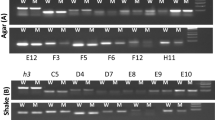Abstract
Biosynthesis of trichothecenes requires the involvement of at least 15 genes, most of which have been targeted for PCR. Qualitative PCRs are used to assign chemotypes to individual isolates, e.g., the capacity to produce type A and/or type B trichothecenes. Many regions in the core cluster (consisting of 12 genes) including intergenic regions have been used as targets for PCR, but the most robust assays are targeted to the tri3 and tri12 genes. Quantitative PCRs, that work across trichothecene-producing members of the Fusarium head blight complex, are described along with procedures to quantify the amount of fungal biomass in wheat samples. These assays are directed to the chemotype(s) present in field samples and quantify the total fungal biomass of trichothecene-producing fungi, irrespective of their genetic identity.
Access this chapter
Tax calculation will be finalised at checkout
Purchases are for personal use only
Similar content being viewed by others
References
Alexander NJ, Proctor RH, McCormick SP (2009) Genes, gene clusters, and biosynthesis of trichothecenes and fumonisins in Fusarium. Toxin Rev 28:198–215
Kimura M, Tokai T, Takahashi-Ando N et al (2007) Molecular and genetic studies of fusarium trichothecene biosynthesis: pathways, genes, and evolution. Biosci Biotechnol Biochem 71:2105–2123
McCormick SP, Stanley AM, Stover NA et al (2011) Trichothecenes: from simple to complex mycotoxins. Toxins 3:802–814
Proctor RH, McCormick SP, Alexander NJ et al (2009) Evidence that a secondary metabolic biosynthetic gene cluster has grown by gene relocation during evolution of the filamentous fungus Fusarium. Mol Microbiol 74:1128–1142
Rep M, Kistler HC (2010) The genomic organization of plant pathogenicity in Fusarium species. Curr Opin Plant Biol 13:420–426
Alexander NJ, McCormick SP, Waalwijk C et al (2011) The Genetic Basis for 3-ADON and 15-ADON Trichothecene Chemotypes in Fusarium. Fungal Genet Biol 48:485–495
Brown DW, McCormick SP, Alexander NJ et al (2001) A Genetic and Biochemical Approach to Study Trichothecene Diversity in Fusarium sporotrichioides and Fusarium graminearum. Fungal Genet Biol 32:121–133
Brown DW, McCormick SP, Alexander NJ et al (2002) Inactivation of a cytochrome P-450 is a determinant of trichothecene diversity in Fusarium species. Fungal Genet Biol 36:224–233
Lee T, Oh DW, Kim HS et al (2001) Identification of deoxynivalenol- and nivalenol-producing chemotypes of Gibberellazeae by using PCR. Appl Environ Microbiol 67:2966–2972
Zhang H, Zhang Z, van der Lee T et al (2010) Population genetic analyses of Fusarium asiaticum populations from barley suggest a recent shift favoring 3ADON producers in southern China. Phytopathology 100:328–336
Ward TJ, Bielawski JP, Kistler HC et al (2002) Ancestral polymorphism and adaptive evolution in the trichothecene mycotoxin gene cluster of phytopathogenic Fusarium. Proc Natl Acad Sci U S A 99:9278–9283
Waalwijk C, Köhl J, De Vries I et al (2009) Fusarium in winter tarwe (in 2007 en 2008) (in Dutch). Wageningen, The Netherlands, Plant Research International. Report 272
Kulik T (2011) Development of TaqMan assays for 3ADON, 15ADON and NIV Fusarium genotypes based on Tri12 gene. Cereal Res Commun 39:200–214
O’Donnell K, Kistler HC, Tacke BK et al (2000) Gene genealogies reveal global phylogeographic structure and reproductive isolation among lineages of Fusarium graminearum, the fungus causing wheat scab. Proc Natl Acad Sci U S A 97:7905–7910
Yang LJ, van der Lee TAJ, Yang XJ et al (2008) Fusarium Populations on Chinese Barley Show a Dramatic Gradient in Mycotoxin Profiles. Phytopathology 98:719–727
Acknowledgments
This work was supported by the MycoRed project (FP7 Food Quality and Safety Priority—Large Collaborative Project—GA 222690) and the Dutch Main Board for Arable Products.
Author information
Authors and Affiliations
Corresponding author
Editor information
Editors and Affiliations
Rights and permissions
Copyright information
© 2017 Springer Science+Business Media LLC
About this protocol
Cite this protocol
Wei, S., van der Lee, T., Verstappen, E., van Gent, M., Waalwijk, C. (2017). Targeting Trichothecene Biosynthetic Genes. In: Moretti, A., Susca, A. (eds) Mycotoxigenic Fungi. Methods in Molecular Biology, vol 1542. Humana Press, New York, NY. https://doi.org/10.1007/978-1-4939-6707-0_11
Download citation
DOI: https://doi.org/10.1007/978-1-4939-6707-0_11
Published:
Publisher Name: Humana Press, New York, NY
Print ISBN: 978-1-4939-6705-6
Online ISBN: 978-1-4939-6707-0
eBook Packages: Springer Protocols




